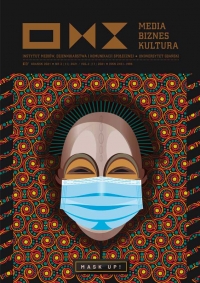Młodzież w sieci w czasie pandemii. Diagnoza, problemy, wyzwania
Słowa kluczowe:
social media, internet, mózg, pandemia COVID-19, informacja, nastolatki, młodzież, uzależnienia, PTSD, nadużycia, izolacjaAbstrakt
Świat postpandemiczny młodzieży jest kalejdoskopem wielu zmian. Wyłaniający się z licznych badań obraz problemów i wyzwań, z którymi się mierzyli w okresie pandemii młodzi ludzie, wymaga niewątpliwie badań pogłębionych, a nawet niezwykle wymagających i rzadko prowadzonych w socjologii tak zwanych badań podłużnych. Jednak punktem wyjścia do dalszych analiz w tego rodzaju diagnozie jest wstępny przegląd badań dostępnych na świecie i dotyczących problemów, z którymi mierzyli się młodzi ludzie w czasie pandemii COVID-19, szczególnie w pierwszej i drugiej jej fali. Po dokonaniu przeglądu i analizy najważniejszych, najciekawszych i przeprowadzonych na dużej populacji wyników badań empirycznych w Polsce i na świecie wybrano zatem spośród nich symptomatyczne dla diagnozy problemów i wyzwań, które należy zmapować, aby móc dalej je obserwować i badać. Artykuł ma charakter eksploracyjny i problemowy, nakreślający problematykę zjawisk, które w czasie pandemii w wyraźny sposób ujawniły się w populacji młodzieży. Cel dokonanego przeglądu badań to ich analiza porównawcza, a następnie wskazanie najważniejszych zjawisk i zagadnień, które warto badać w populacji młodzieży w czasie czwartej fali pandemii oraz po jej zakończeniu, w czasach pandemicznych.
Downloads
Bibliografia
Ambroziak K., Kołakowski A., Siwek K., Depresja nastolatków. Jak ją rozpoznać, zrozumieć i pokonać, Gdańskie Wydawnictwo Psychologiczne, Sopot 2018.
Bajaj G.S., Prajapati P., The Impact of the COVID-19 Pandemic on Child and Adolescent Mental Health Conditions, „Harvard Medical Student Review”, 21.02.2021, https://www.hmsreview.org/covid/child-and-adolescent-mental-health (dostęp: 12.10.2021).
Bauerlein M., The Dumbest Generation. How the Digital Age Stupefies Young Americans and Jeopardizes Our Future (Or, Don’t Trust Anyone Under 30), TarcherPerigee, New York 2008.
Bocian K., Jak smartfon zmienia Twój mózg, https://www.newsweek.pl/wiedza/psychologia/technologia-jak-smartfon-zmienia-twoj-mozg/e97gw2s (dostęp: 12.10.2021).
Flores S.E., Sfejsowani. Jak media społecznościowe wpływają na nasze życie, emocje i relacje z innymi, przeł. K. Mojkowska, Wydawnictwo Muza, Warszawa 2017.
Frączak M., Statystyki korzystania z internetu przez dzieci, https://www.dziennikprawny.pl/pl/a/co-to-jest-efekt-fomo (dostęp: 12.10.2021).
Gordhamer S., Wisdom 2.0. Ancient Secrets for the Creative and Constantly Connected, Harper Collins, New York 2009.
Guessoum S.B. et al., Adolescent psychiatric disorders during the COVID-19 pandemic and lockdown, „Psychiatry Research” 2020, No. 291, 113264, https://www.ncbi.nlm.nih.gov/pmc/articles/PMC7323662/ (dostęp: 12.10.2021).
Jackson M., Distracted. The Erosion of Attention and the Coming Dark Age, Amherst, Prometheus Books, New York 2009.
Klinger K., Otto P., Tabletką w stresogennego koronawirusa. Sprzedaż leków antydepresyjnych i uspokajających zwiększyła się, „Dziennik Gazeta Prawna”, https://serwisy.gazetaprawna.pl/zdrowie/artykuly/1469668,koronawirus-sprzedaz-lekow-antydepresyjnych-uspokajajacych.html (dostęp: 12.10.2021).
Kocur J., Trendak W., Czynniki ryzyka samobójczego uzależnieniach behawioralnych, „Suicydologia” 2016, t. VIII, s. 51–55.
Kościelniak P., Smartfon zmienia mózg, https://www.rp.pl/artykul/1189271-Smartfon-zmienia-mozg.html (dostęp: 12.10.2021).
Maushart S., e-Migranci. Pół roku bez internetu, telefonu i telewizji, Społeczny Instytut Wydawniczy Znak, Kraków 2014.
Nastolatki 3.0. Raport z ogólnopolskiego badania uczniów, red. R. Lange, NASK, Warszawa 2021, https://akademia.nask.pl/badania/_media_2021_09_Thinkstat_Nastolatki_3.0-Digital.pdf (dostęp: 12.10.2021).
Orzeł-Gryglewska J., Zaburzenia snu związane z nadmierną ekspozycją na światło, „Polish Journal for Sustainable Development” 2017, t. 21(2), s. 91–100.
Osit M., Generation Text. Raising Well-Adjusted Kids in the Age of Instant Everything, AMACOM, New York 2008.
Palfrey J., Glasser U., Born Digital. Understanding the First Generation of Digital Natives, Basic Books, New York 2008.
Pandemia COVID-19 doprowadziła Polaków na skraj załamania nerwowego, https://forsal.pl/lifestyle/zdrowie/artykuly/8024925,pandemia-COVID-19-doprowadzila-polakow-na-skraj-zalamania-nerwowego.html (dostęp: 12.10.2021).
Rejniak R., Zdrowie psychiczne młodzieży w czasie pandemii COVID-19, https://programyrekomendowane.pl/strony/zdrowie-psychiczne-mlodziezy-w-czasie-pandemii-COVID-19,422 (dostęp: 12.10.2021).
Singh S. et al., Impact of COVID-19 and lockdown on mental health of children and adolescents: A narrative review with recommendations, „Psychiatry Research” 2020, No. 293, 113429.
Small G., Vorgan G., iBrain. Surviving the Technological Alternation of the Modern Mind, William Morrow Paperbacks, New York 2008.
Smartfony i tablety niszczą mózgi dzieci, nie zastąpią im opiekunów. Raport Amerykańskiego Towarzystwa Medycznego, https://www.telepol9is.pl/wiadomosci/prawo-finanse-statystyki/smartfony-i-tablety-niszcza-mozgi-dzieci-nie-zastapia-im-opiekunow (dostęp: 12.10.2021).
Szaniawska M., Używanie smartfona powoduje nieodwracalne zmiany w mózgu. Szokujący raport, https://superbiz.se.pl/wiadomosci/uzywanie-smartfona-powoduje-nieodwracalne-zmiany-w-mozgu-szokujacy-raport-aa-9SgL-NYRw-E5CF.html (dostęp: 12.10.2021).
Taquet M., Geddes J.R., Husain M., Luciano S., Harrison P.J., 6-month neurological and psychiatric outcomes in 236 379 survivors of COVID-19: a retrospective cohort study using electronic health records, „Lancet Psychiatry” 2021, No. 8(5), s. 416–427.
Tapscott D., Cyfrowa dorosłość. Jak pokolenie sieci zmienia nasz świat, przeł. P. Cypryański, Wydawnictwa Akademickie i Profesjonalne, Warszawa 2010.
Twenge J.M., iGen. Dlaczego dzieciaki dorastające w sieci są mniej zbuntowane, bardziej tolerancyjne, mniej szczęśliwe – i zupełnie nieprzygotowane do dorosłości i co to oznacza dla nas wszystkich, przeł. O. Dziedzic, Smak Słowa, Sopot 2019.
WHO: więcej ruchu, mniej ekranów. Nowe wytyczne dla dzieci poniżej 5 r.ż., https://www.politykazdrowotna.com/44207,who-wiecej-ruchu-mniej-ekranow-nowe-wytyczne-dla-dzieci-ponizej-5-rz (dostęp: 12.10.2021).
World Health Organization, Guidelines on Physical Activity, Sedentary Behaviour and Sleep for Children Under 5 Years Of Age, 2019, https://apps.who.int/iris/bitstream/handle/10665/311664/9789241550536-eng.pdf?sequence=1&isAllowed=y, (dostęp: 12.10.2021).
Zdalna edukacja – gdzie byliśmy, dokąd idziemy? Wstępne wyniki badania naukowego „Zdalne nauczanie a adaptacja do warunków społecznych w czasie epidemii koronawirusa”, Warszawa, czerwiec 2020, https://zdalnenauczanie.org/wp-content/uploads/2020/06/Badanie-zdalnenauczanie_org_prezentacja.pdf (dostęp: 12.10.2021).
Zdrowie psychiczne w czasie pandemii COVID-19. Raport wstępny z badania naukowego kierowanego przez dr hab. Małgorzatę Dragan, http://psych.uw.edu.pl/2020/05/04/zdrowie-psychiczne-w-czasie-pandemii-COVID-19-raport-wstepny-z-badania-naukowego-kierowanego-przez-dr-hab-malgorzate-dragan/ (dostęp: 12.10.2021).
Żarczyńska-Dobiesz A., Chomątowska B., Pokolenie Z na rynku pracy – wyzwania dla zarządzania zasobami ludzkimi [w:] Sukces w zarządzaniu kadrami. Różnorodność w zarządzaniu kapitałem ludzkim – podejścia, metody, narzędzia, „Prace Naukowe Uniwersytetu Ekonomicznego”, nr 350, red. M. Stor, A. Fornalczyk, Wydawnictwo Uniwersytetu Ekonomicznego we Wrocławiu, Wrocław 2014.

 Uniwersyteckie Czasopisma Naukowe
Uniwersyteckie Czasopisma Naukowe




